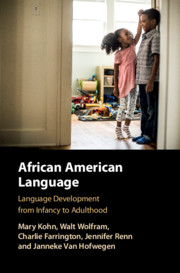Book contents
- African American Language
- African American Language
- Copyright page
- Contents
- Figures
- Tables
- Preface
- Abbreviations
- 1 Coming of Age in African American Language
- 2 The Analysis of Sociolinguistic Change over the Lifespan
- 3 Profiles of Change
- 4 Vowel Variation across Time and Space
- 5 Caretaker’s Influence on Vernacularity
- 6 The Influence of Peers on the Use of African American Language
- 7 Stylistic Variation in the Early AAL Lifespan
- 8 The Relationship of African American Language and Early Literacy Skills
- 9 A Longitudinal Study in Retrospect
- Appendix AAL Feature Code Key
- Index
- References
2 - The Analysis of Sociolinguistic Change over the Lifespan
Published online by Cambridge University Press: 24 November 2020
- African American Language
- African American Language
- Copyright page
- Contents
- Figures
- Tables
- Preface
- Abbreviations
- 1 Coming of Age in African American Language
- 2 The Analysis of Sociolinguistic Change over the Lifespan
- 3 Profiles of Change
- 4 Vowel Variation across Time and Space
- 5 Caretaker’s Influence on Vernacularity
- 6 The Influence of Peers on the Use of African American Language
- 7 Stylistic Variation in the Early AAL Lifespan
- 8 The Relationship of African American Language and Early Literacy Skills
- 9 A Longitudinal Study in Retrospect
- Appendix AAL Feature Code Key
- Index
- References
Summary
The approach to language variation developed over the last half century has focused on systematic variation of variants for a single structural unit under the construct of the linguistic variable. While this approach may offer important detail for particular variables, it is essential to examine the overall configuration of a language variety as well. Composite linguistic measures facilitate the exploration of social factors and offer a profile of change for the entire linguistic system. We describe the methodological tools to provide a global description of language variation, “the composite index”, and to fully capture when and why individuals change their linguistic behavior over time. We emphasize the need to view language as a system by moving beyond individual variables to more fully characterize the ways in which individual linguistic features move in-tandem across the lifespan. The study demonstrates that a composite index score like the Dialect Density Measure (DDM) can be used as a means of tracking trajectories of language use across the lifespan on a unidimensional scale.
Keywords
- Type
- Chapter
- Information
- African American LanguageLanguage development from Infancy to Adulthood, pp. 22 - 45Publisher: Cambridge University PressPrint publication year: 2020

